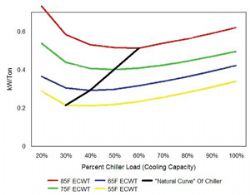WITH the energy consumption of datra centres set to double by 2011, the need to come up with ever more efficient cooling systems is paramount, as Wayne Rose, marketing manager of Armstrong, explains.
According to US EPA figures, increases in processor speed and the need for increased amounts of cooling in data centres will see energy consumption in this sector double to 120 billion kWh by 2011, making it the largest user of energy in the US. And forecasts suggest it will double again in the following five years.
Similar predictions are being made in Europe, where there is increasing concern regarding the carbon impact of IT. A recent German government report estimated that the power consumption of servers and data centres in Germany totalled 10.1TWh in 2008, twice the figure for 2000. This means that Germany's data centres today require a level of supply of electricity equal to the production of nearly four medium-sized coal-fired power stations, and are responsible for CO2 emissions of almost 6,400,000 tonnes in 2008.
There is widespread agreement however that the use of more energy efficient cooling systems could halt and even reverse this trend. The German government report states that if currently available energy efficiency measures were to be adopted by only around half of all data centres, a reduction in electricity consumption of about 10% would be possible. If this 'moderate-efficiency-increase' scenario were to be implemented, the electric power consumption of German data centres would drop to 9.14TWh by 2013.
Technology solutions
Cooling systems currently account for around 40-60% of a datacentre's annual energy bill but achieving significant energy efficiency reductions requires a fundamental rethink of the way in which chiller equipment is managed.
Since a data centre cooling system is required to operate over a greater operating design envelope at varying loads, reliability and efficiency are mostly required at part-load operation. The most effective method to satisfy the continuously varying and critical demands for data centre cooling is to employ all available variable-speed components -- chillers, pumps and fans -- and a control strategy specific to the unique operating characteristic of variable-speed devices. There are no exceptions to this, because constant-speed devices cannot solve the challenges of a varying application such as data centre cooling.
The widely used capacity-based sequencing approach to control, which uses on/off cycling, has proved to be less efficient than more recent integrated control strategies. The more impressive results are being achieved today in data centre applications by balancing demand across the system.
All variable system
Armstrong's IPP-CHW, for example, uses less energy because it is an all-variable, fully automated system. It operates as a single integrated system, rather than as three independent PID loops. As all equipment is fully integrated, energy savings and capacity are automatically traded-off between the individual components, optimising the efficiency of the entire system at all times. Compared to other modern technologies, this type of technology offers an energy reduction of more than 30%. Compared to standard practice the level of energy saving is even higher - anywhere up to 60% energy reduction depending on equipment selection.
With equipment of this type installed, COPs of 7.3 (on an annual average basis) can be achieved compared to a previous best practice COPs of between 3.2 and 2.2.
The efficiencies are made possible in part by the natural curve sequencing approach of the system's control technology, which sequences the variable-speed Quantum chillers to operate along their natural curve for all load conditions. There is an ideal point on a chiller's loading curve for a specific chilled water supply and entering condenser water temperature where that chiller will be operating at its optimum efficiency.

Fig 1: Variable speed chiller performance curves
The natural curve for a chiller is developed by finding these ideal points for the four entering condenser water temperatures for a specific supply chilled water temperature. This point will be the lowest point (lowest kw/ton) on each of the four condenser water temperature curves. The natural curve is then developed by drawing a line that intersects the four points as illustrated in Fig 1.
The Armstrong IPP-CHW similarly controls the variable speed pumps so that they also operate along their natural curve, or 'sweet point'.
Armstrong Pumps
0161 223 2223